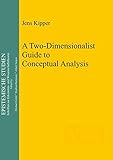A two-dimensionalist guide to conceptual analysis / Jens Kipper.
Material type: TextSeries: Deutsche Hochschulschriften. Epistemische Studien.Publisher: Berlin : De Gruyter, 2012Description: 1 online resource (320 pages)Content type:
TextSeries: Deutsche Hochschulschriften. Epistemische Studien.Publisher: Berlin : De Gruyter, 2012Description: 1 online resource (320 pages)Content type: - text
- computer
- online resource
- 9783110322705 (electronic bk.)
- 3110322706 (electronic bk.)
- 149.94
Preface; Contents; Introduction; 1 What is conceptual analysis and what is the problem?; 1.1 What is conceptual analysis?; 1.2 From Frege to Kripke and Putnam; 2 Two-dimensionalism and the necessary a posteriori; 2.1 Two-dimensionalism; 2.1.1 Primary and secondary intensions; 2.1.2 Metaphysical plenitude and two-fold world dependence; 2.1.3 Scrutability and canonical descriptions; 2.1.4 Two-dimensionalism and Jackson's descriptivism; 2.1.5 Two notions of apriority; 2.2 Modal illusions according to Kripke and according to twodimensionalism; 2.2.1 Kripke's two models of modal error.
2.2.2 Doubts about the accounts of modal error2.2.2.1 Doubts about the epistemic counterpart model; 2.2.2.2 Doubts about the reference fixer model; 2.3 Summary and outlook: What has been shown and what is yet to be shown; 3 The challenge from the epistemic arguments; 3.1 Primary intensions and the epistemic arguments; 3.1.1 The primary intensions of natural kind terms; 3.1.1.1 Vagueness; 3.1.1.2 Intersubjective variation and the individuation of concepts .; 3.1.2 Semantic deference and the primary intensions of names; 3.1.2.1 The argument from Ignorance and Error.
3.1.2.2 Deferential concepts and the alleged problem of circularity3.1.2.3 Deferential concepts and apriority; 3.1.2.4 Two methods for detecting deferential concepts and two problems for two-dimensionalism; 3.2 Linguistic meaning, mental content, and two-dimensionalism; 4 Primary intensions, defining the subject, and communication; 4.1 Defining the subject; 4.1.1 A case for the epistemic thesis; 4.1.1.1 From (CJ) to (CJ+) -- Schroeter's improv model; 4.1.1.2 From (CJ+) to (CJ++); 4.1.2 The failure of the semantic thesis; 4.2 Two-dimensional communication; 4.2.1 The semantic thesis.
4.2.1.1 Communication involving indexical expressions4.2.1.2 Communication involving proper names; 4.2.1.3 Communication involving natural kind terms; 4.2.2 The epistemic thesis; 4.2.2.1 The importance of shared primary intensions; 4.2.2.2 How primary intensions help to promote co-reference even when they are not shared; 4.2.2.2.1 Proper names; 4.2.2.2.2 Natural kind terms; 5 Epistemic transparency and epistemic opacity; 5.1 Arguments for ubiquitous opacity; 5.1.1 Millikan; 5.1.2 Putnam; 5.1.3 Kornblith; 5.2 Revealing opacity; 5.2.1 Revealing opacity via the function of a term.
5.2.2 Revealing opacity via considerations about hypothetical cases5.2.3 Can opacity be determined a priori?; 5.3 The value of opaque terms in conceptual analysis; 5.3.1 Discovering essences; 5.3.2 Variation in primary intensions; 6 Scrutability, primary intensions, and conceptual analysis; 6.1 Scrutability and primary intensions; 6.1.1 From descriptivism to the scrutability thesis; 6.1.2 A case for (CJ); 6.1.2.1 Argument from metaphysical plenitude; 6.1.2.2 Arguments from the scrutability of specific kinds of facts .; 6.1.2.3 Arguments from the absence of clear counterexamples.
6.1.2.4 Arguments from the epistemic indispensability of scrutability.
According to epistemic two-dimensionalism, or simply twodimensionalism, linguistic expressions are associated with two intensions, one of which represents an expression's a priori implications. The author investigates the prospects of conceptual analysis on the basis of a twodimensionalist theory of meaning. He discusses a number of arguments for and against two-dimensional semantics and argues that properly construed, two-dimensionalism provides a potent and plausible account of meaning. Against the background of this account, the author then goes on to assess the value of conceptual analysis.
Description based on print version record.

There are no comments on this title.